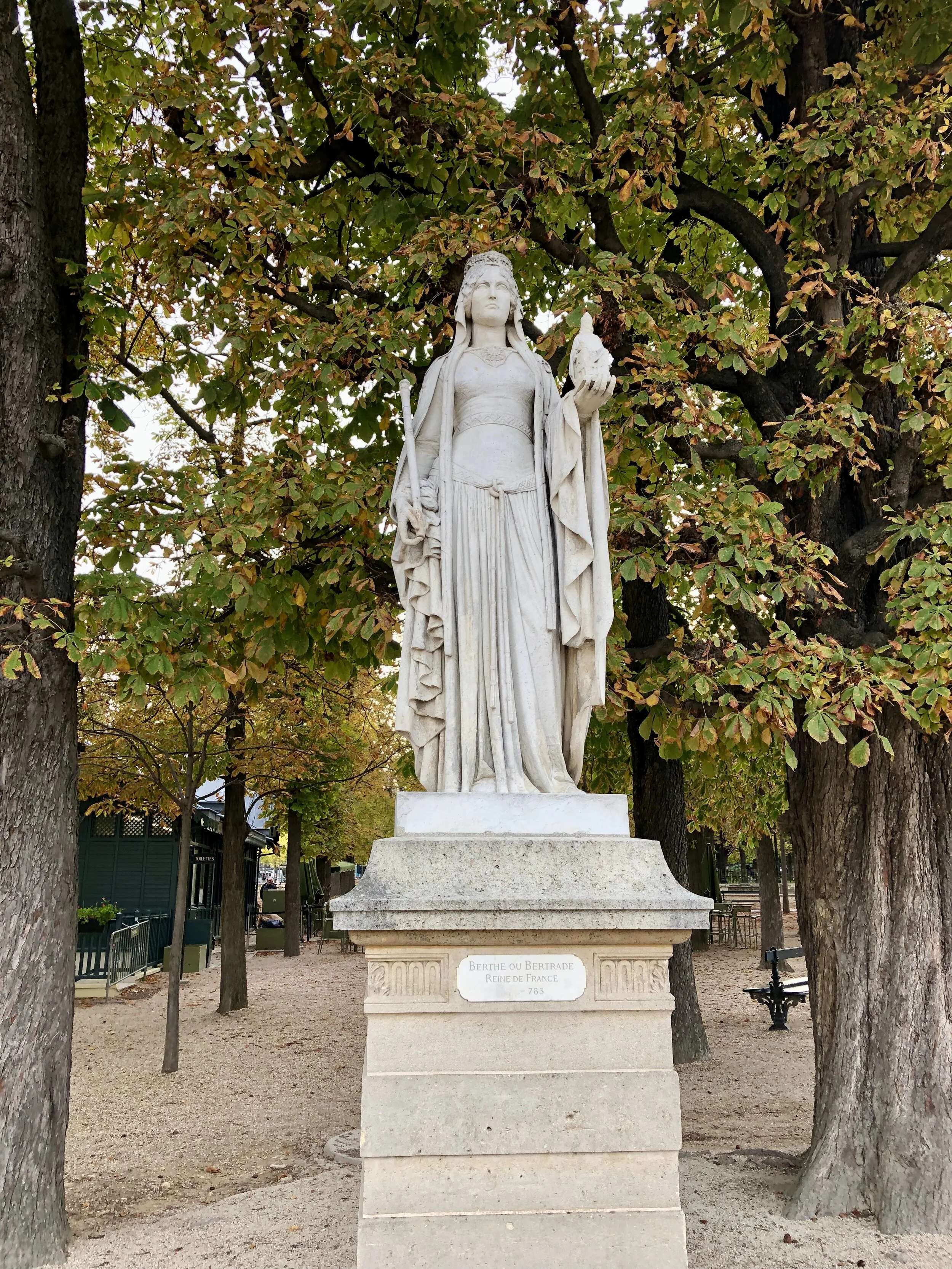The statue of Reine Berthe in the Jardin du Luxembourg is one of my favorites of the twenty illustrious ladies in French history. She may not be as well known as Marie de Medicis but you will know the name of her son and her story is pretty amazing.
Born in 720 to Count Caribert de Laon and Blanche-Fleur de Prum her beauty was known far and wide. When Pepin le Bref, future king of the Franks heard of her stunning beauty he wanted her for his wife. Different histories say he may have been married before to Leutburgie and when he heard of Berthe, he asked Leutburgie to leave court. The marriage was arranged and Berthe headed to court to meet her future husband.
Traveling to court with her cousin Tybers and servant Margiste and his daughter Aliste who didn’t have the best of intentions. Margiste realized his daughter had a striking resemblance to Berthe and hatched a plan to replace the princess with his own daughter. He convinced Berthe that Pepin was a horrible brutal man, kidnapped her and planned to behead her. Luckily one of his men overheard and released Berthe in the forest of Le Mans. For years Berthe lived in a farmers home in the forest while Aliste lived her life in court until one day her mother came to town.
Missing her lovely daughter she went to court and with one look she knew Aliste was not her beloved Berthe. Pepin and everyone at court told her she was wrong but Berthe had one distinct feature that couldn’t be faked. Berthe was also known as Berthe au Grand Pied due to her clubfoot. Her left foot was much larger than her right and all Blanche-Fleur had to do was lift her blanket to see this was not her daughter. Margiste and Aliste were arrested and burned to death but still Berthe was missing.
One day as Pepin and his men were hunting in Le Mans he came across a beautiful woman praying in the woods, he and Berthe were finally united. Returning to court they were married in 743 or 744 and on April 2, 748 she gave birth to her first child, Charles followed in 751 by Carloman and five more children. Only three would survive to adulthood.
Pepin’s father Charles Mantel held the title of the “Mayor of the Palace”, at the time the most powerful role one could hold in the Merovingian dynasty. In 741, Charles died and left his kingdom to be ruled by his two sons, Pepin and Carloman. In 747 he forced his brother out and held the title on his own. At the time Merovingian king Childeric III was in power and Pepin had eyes on his throne. Pepin was a defender and supporter of Pope Zacharius and asked how he could remove him. The Pope told him he was the one that held the power and could do whatever he wanted. Pepin had Childeric III sent to a monastery in 751 and crowned himself King of the Franks.
In 768 Pepin died and left his throne to his two sons, Charles and Carloman. At first the two brothers ruled together and Berthe was involved in every aspect of the court. In 771 Carloman died unexpectedly and instead of giving his portion and power to Carloman’s son he decide to cut him out and rule alone.
Berthe tried to reason with Charles who was not going to change his mind and in turn sent his mother away from court and to Choisy-au-Bac near Compiegne. Berthe would die on July 12, 1783 at 63 years old. Buried at the Église Saint Étienne in Choisy-au-Bac she was later moved to the Basilique Saint Denis to lay next to her husband Pepin.
As for Charles, you may know him better as Charlemagne, king of the Franks and Emperor of the Romans.
Berthe, the lovely woman that went through so much to become the mother of the Father of Europe is rarely talked about. On the upper eastern terrace of the Jardin du Luxembourg, I love her statue by Eugène Ouidné created in 1856. With a strong fierce look on her face, in her hand she holds a small throne that her son Charlemagne sits on under the rustling trees on a perfect fall day.




